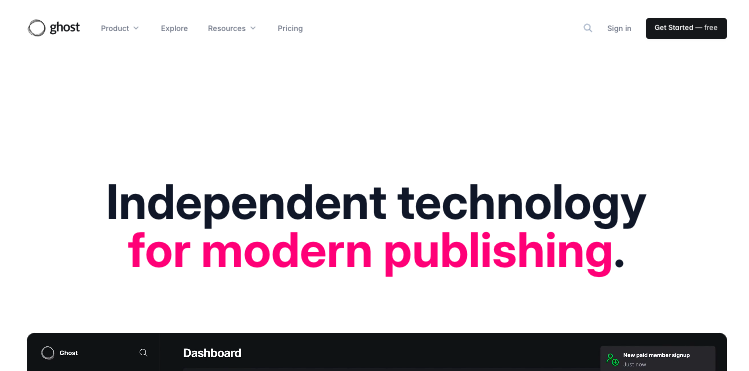Are you a creator or publisher looking for the best platform to run your premium newsletter?
Look no further, because in this article, we will compare two popular newsletter platforms, Substack and Ghost, to help you get started with a reliable tool.
Substack is a hosted newsletter platform that offers basic features for newsletter creation and member management.
On the other hand, Ghost is an open-source CMS that provides more customization and control over your newsletter.
So, how do Substack and Ghost compare in terms of features, pricing, and monetization options?
Let’s dive in and find out.
Substack – Features & Overview
Substack is a popular newsletter platform that offers a range of features for creators and publishers.
With Substack, you can easily create and manage newsletters, delivering content to both free and paid subscribers.
Some of the key features of Substack include:
- Newsletter creation: Substack provides a user-friendly editor that allows you to create engaging newsletters with ease.
- Member management: You can manage your subscribers, track their engagement, and interact with them directly through Substack’s member management tools.
- Free and paid models: Substack offers both free and paid subscription models, giving you flexibility in monetizing your content.
However, it is important to note that Substack has its limitations compared to other platforms like Ghost.
Substack has a limited range of customization options and integrations, making it less flexible for publishers who want more control over their newsletters.
Additionally, Substack charges a 10% fee on subscription revenue, with additional fees applied on earnings over $50,000 per year.
Substack also has concerns about its discoverability on search engines. The platform lacks advanced SEO features, which can impact your newsletter’s visibility and growth.
Furthermore, Substack has limited email customization options, restricting your ability to create personalized and branded communications.
While Substack offers a straightforward platform for newsletter creation and management, its limitations in terms of customization, integrations, and SEO capabilities may not be suitable for publishers seeking more control and flexibility over their newsletters.
Ghost – Features & Overview
Ghost offers creators and publishers a range of powerful features that set it apart from other platforms like Substack.
Let’s explore some of the standout features of Ghost:
1. Customization and Branding: Ghost allows for full customization and branding, giving you complete control over the look and feel of your website and newsletter.
You can choose from a variety of themes and styles to create a unique and professional online presence.
2. Extensive App Integration: Publishers on Ghost have access to over 6,000 connected apps, making it easy to extend the functionality of your website.
Whether you need analytics, email marketing tools, or social media integration, Ghost has you covered.
3. Seamless Migration: If you’re currently using Substack and want to switch to Ghost, the migration process is smooth and hassle-free.
You can easily transfer all your content, subscribers, subscriptions, and payments, ensuring a seamless transition for your audience.
5. Advanced SEO Features: Ghost is widely acclaimed for its SEO capabilities. The platform offers custom domain support, meta description customization, sitemap creation, canonical tags, and more.
These SEO features contribute to better search engine rankings for your content.
With Ghost, you can take your newsletter to the next level with its powerful features, customization options, and SEO-friendly tools.
Also Read: Beehiiv Pricing Plans Explained
Pricing of Substack
Pricing a Substack newsletter involves several factors to consider, including the value of your content, the pricing of comparable newsletters, the size and loyalty of your subscriber base, and your own time and resources.
Here are some key points to keep in mind:
- Pricing Models:
- Monthly Subscription: The most common pricing model, where subscribers pay a set fee each month.
- Annual Subscription: Offers a discount for committing to a longer period.
- Pay-per-Post: Subscribers only pay when new content is published.
- Initial Pricing:
- Start with a Lower Price: As a new writer, it’s recommended to start with a lower price to attract more readers and build your reputation. You can always increase your price as you grow your subscriber base and improve your content.
- Adjusting Your Price:
- Communicate with Subscribers: When adjusting your price, it’s essential to communicate with your subscribers, explaining why the change is necessary and how it will affect their subscription.
- Offer Incentives: Consider offering a discount or other incentives to encourage subscribers to stick around.
- Competitive Pricing:
- Research Comparable Newsletters: Analyze the pricing of similar newsletters on Substack to determine a competitive price.
- Consider Your Target Audience: Take into account the income and spending habits of your target audience when setting your price.
- High-End Pricing:
- Niche Content: High-priced newsletters often provide niche content that is highly valuable to a specific audience.
- Frequent Publishing: Publishing multiple times a week can add value and justify higher prices.
- Small Audience: High-priced newsletters with small audiences can still be lucrative due to the high revenue per subscriber.
- Substack Fees:
- Writer Fees: Substack charges a 10% cut from each transaction, and Stripe charges a credit card processing fee (2.9% + $0.30 per transaction) and a Billing fee for recurring subscriptions (0.5% for recurring payments)
By considering these factors and adjusting your pricing strategy accordingly, you can maximize your earnings on Substack while providing value to your subscribers.
Explore: Beehiiv vs Substack
Pricing of Ghost
When it comes to pricing, Ghost offers a variety of plans to suit your needs.
Their pricing starts at just $11 per month, making it an affordable option for creators and publishers.
Unlike Substack, Ghost charges no fees or commissions on subscription revenue, allowing you to keep all the revenue you make from your newsletter.
This is a significant advantage, especially for those with a large subscriber base.
Ghost offers 4 pricing plans, Stater ($11/m), Creator ($31/m), Team ($63/m), & Business ($249/m). You have both monthly and yearly payment options.
This flexibility allows you to choose a plan that aligns with your budget and requirements. Whether you’re just starting out or have an established audience, Ghost has a pricing plan that fits your needs.
Furthermore, Ghost offers support for 135 global currencies, compared to Substack’s support for only 13 western currencies.
The global reach enables creators from all around the world to easily monetize their newsletters and cater to an international audience, without the hassle of currency conversions.
Another advantage of Ghost is the absence of additional costs for features like custom domains. Substack, on the other hand, charges a one-time fee of $50 for custom domain connection.
With Ghost, you can create a branded profile and have full control over your content and brand, without any limitations.
To make the pricing even more transparent, Ghost provides a detailed breakdown of their pricing plans on their website.
This allows you to understand exactly what you’re paying for and make an informed decision based on your specific needs and goals.
Migrating from Substack to Ghost is also seamless, with no disruption to your subscribers, subscriptions, and payments.
Ghost’s user-friendly interface and intuitive migration process ensure a smooth transition, saving you time and effort.
Also Read: Mailchimp vs Beehiiv
Monetization
Substack
Substack provides several monetization options for creators looking to generate revenue from their newsletters.
The platform allows you to offer both free and paid subscriptions, giving you the flexibility to choose the content accessible to different audiences.
With Substack, you have the opportunity to earn revenue from paying subscribers who value your premium content.
Substack takes a 10% cut of your subscription revenue, ensuring that you benefit from the income you generate.
In addition to the subscription model, Substack offers basic SEO features to help improve your discoverability on search engines. This includes customizable metadata, sitemaps, and structured URLs.
However, it’s important to note that Substack has limited options for monetization beyond subscriptions.
The platform primarily focuses on generating revenue through the subscription model, and customization options are restricted compared to other platforms.
Explore: Brevo vs Systeme
Ghost
If you’re looking for various ways to monetize your newsletter, Ghost provides a range of options to help you generate revenue.
One of the primary ways to monetize your newsletter on Ghost is through paid memberships. You can offer exclusive content, early access, or additional perks to your paying subscribers.
Ghost prioritizes creators by providing a 0% membership fee, allowing you to keep all the earnings from your memberships.
Moreover, Ghost goes beyond memberships and offers further monetization opportunities. You can run display ads on your Ghost website, opening up additional revenue streams.
This allows you to tap into advertising partnerships and maximize your earnings.
Additionally, Ghost supports integrations with other platforms like Patreon, giving you the option to diversify your revenue beyond subscriptions.
By embedding sponsored content in your posts, you can collaborate with brands and monetize your newsletters in creative ways.
Unlike Substack, Ghost doesn’t charge any fees on subscription revenue. This means that as a creator, you get to keep all the earnings you make from your newsletter.
With Ghost’s emphasis on empowering creators, your revenue potential is maximized.
Ghost understands the importance of visibility and reaching a wider audience. The platform offers SEO-friendly elements such as structured URLs, tags, and meta descriptions.
This ensures that your content is easily discoverable by search engines, driving organic traffic to your website and increasing your revenue potential.
With Ghost’s focus on monetization options, zero membership fees, and SEO-friendly features, it’s an excellent choice for creators who want to maximize their revenue potential and establish a sustainable income stream from their newsletters.
Explore: Beehiiv Review
SEO Capabilities
Substack
When it comes to SEO capabilities, Substack offers some basic features that can help improve your discoverability on search engines.
The platform allows you to use a custom domain, which can make your website appear more professional and trustworthy to both search engines and readers.
Additionally, Substack allows you to customize the meta description of your content, which plays a crucial role in attracting organic traffic by providing users with a preview of what your content is about.
In terms of technical SEO, Substack generates an XML sitemap automatically, making it easier for search engines to crawl and index your content.
The platform also provides a robots.txt file, which allows you to control how search engines access and interpret your website.
These features are essential for optimizing your website’s visibility on search engines, as they facilitate the indexing process.
However, it is important to note that there have been concerns about Substack’s discoverability on search engines.
Due to the platform’s limitations, it can be challenging to rank well on search engine result pages (SERPs) without specifically using the word “Substack” in the search query.
This limitation can impact your website’s organic traffic potential, as it relies heavily on brand recognition rather than content relevance.
While Substack offers some SEO capabilities, it may not be the most effective platform if you prioritize organic search traffic and discoverability.
For creators who want to optimize their content for search engines and reach a wider audience, a platform like Ghost CMS is recommended.
Explore: Systeme vs Beehiiv
Ghost
Ghost CMS, on the other hand, provides a range of SEO tools and features that can significantly enhance your website’s visibility on search engines.
With Ghost, you have more control over your SEO by having the ability to customize URL slugs, which help search engines understand the context and relevance of your content.
You can also fully customize the meta descriptions for each piece of content, allowing you to optimize the preview text shown on search engine result pages.
Additionally, Ghost CMS supports canonical tags, ensuring that search engines properly attribute content to the original source, reducing the risk of duplicate content issues.
Furthermore, Ghost CMS is optimized for speed and performance, another important factor in SEO.
It generates XML sitemaps automatically and includes built-in features like Google AMP (Accelerated Mobile Pages), which can improve your website’s mobile performance and user experience.
These technical advantages give your website an edge when it comes to search engine rankings, making it easier for users to find your content.
Check Out: MailerLite vs Beehiiv
Conclusion
As you can see, both the platforms have their strengths and cater to different needs.
If you’re planning to grow a community of paying subscribers and value flexibility in site setup without added complexity, Ghost is the recommended platform for you.
On the other hand, if you prefer an easy setup process and prioritize simplicity, Substack may be the better choice.
Ultimately, your decision should be based on your specific needs, budget, and long-term goals.
Consider the features, pricing, monetization options, and SEO capabilities of both Substack and Ghost to choose the best platform for your newsletter.















